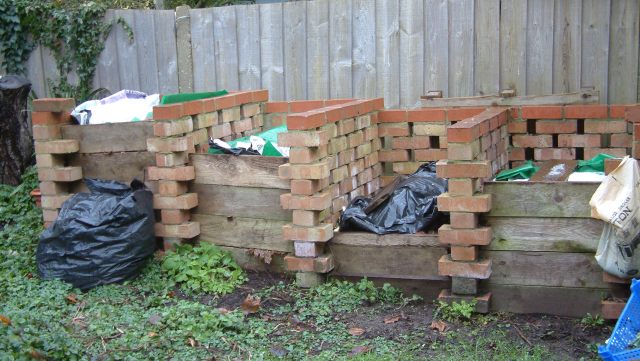
| Our four compartment composter, two for leafmould, and two for compost [1]. Note the stump on the left. Rose chafer larvae feed happily in all of them. Photo taken on February 9 2007. |

| Our four compartment composter, two for leafmould, and two for compost [1]. Note the stump on the left. Rose chafer larvae feed happily in all of them. Photo taken on February 9 2007. |
What exactly are they?
Well, their end result is those beautiful metallic green rose chafers, the jewels of the allotment, to be found sipping on flowers. From April onwards, look out for them on rhubarb fronds, then on parsnip flowers, and artichoke flowers by the summer, see photo.
Back to the fat tightly curled wrinkled grubs, if you really want to make sure of their identification, just watch what they do when placed on a flat surface. They unroll, turn on their backs and start a back stroke, "crawly backs" is what they are called in America, see photo. The other, bigger-headed and longer-legged, grubs to be found while digging, and never in the compost, will move away quickly as if dragging a sleeping bag behind, a very different behaviour. Those feed on fresh roots only, and are summer chafer grubs, but that is another story...[2]
Around the end of June those big fat grubs will leave the compost to pupate in the soil, and that is where the beetles will mostly stay until they emerge the next spring. I say mostly because some of them are tempted to come out in the autumn.
However they will only mate in the spring, see photo, then they will lay eggs in the compost and by mid-summer, with luck, you could spot them again doing a good job in your compost. Those grubs will overwinter in the compost, and pupate at the beginning of next summer. Their life cycle lasts two years.
I've read that rose chafers aren't as common as they used to be, so to make sure that we aren't going to run out of jewels the best thing to do when you want to use your grubby compost is to put them aside as you find them, then at the end put them back in the pile. This is exactly what I've done, and also tucked some in my allotment manure heap as they like that too.
Just a word of warning for those using the lidded conical plastic bins, in the spring it is well worth having a look inside, now and again, so that the emerged beetles won't get trapped, and lose their chance to mate.
Maria Fremlin
Plot 27, Drury Road site, Colchester
This article was written for the Colchester Allotment Association in August 2006, but it never got published, instead it spawned a Rose Chafer Survey. Please enter your records, even if they are null.
[1] - Our composter was a very nice 25th wedding anniversary present from my husband, back in 1997. He designed it by making a double “New Zealand box” with ventilation at the sides, to suit our needs, that is, two containers for leafmould and two for compost. This was based on the supplement Step-by-Step Organic Gardening Composting, Henry Doubleday Research Association, Newsletter 112, 1998. This article hasn't got an author's name, but I rather suspect that it was based on Lawrence D. Hills's ideas. To me he was the compost king, a very inspiring person.
Our four container composter has worked very well, while one compost bin is being topped up (the black covered one in the photo), the other is ready to be used. Moreover the one which is being topped up always manages to maintain the heat throughout the year. Back to the photo, that back plastic bag is full of leaves is ready to be added to the 2 leafmould piles made last autumn, the ones on the left. Those also heat up... No wonder so many grubs can be found in all of them.
To me, making compost is an absolutely essential part of gardening, challenging but very rewarding.
[2] - For more about grubs found while digging see “Cockchafer” or Summer chafer in my Gardener's Larva Guide.
Links:
Fotogalerij Jan Henderickx - Jan Henderickx has larvae of lesser stag beetle Dorcus parallelipipedus and rhinoceros beetle Oryctes nasicornis in his compost pile. In the Netherlands rose chafers Cetonia aurata are very rare indeed.
Container composting - A basic article in Wikipedia describing the “New Zealand box”.
Rose Chafer Survey - Please enter your records even if they are null, as it would be very interesting to get an update view on the distribution of this beetle.
Last modified: Sat Jan 24 11:11:57 GMT 2009
| Main | Gardener's Larva Guide | Rose chafer photos | Stag beetles in my back garden |